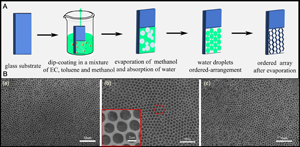Published online by Cambridge University Press: 16 November 2020

A simple and effective strategy is proposed for fabricating honeycomb-patterned ethyl cellulose (EC) films via a combination of the dip-coating and breath figure methods under a wide humidity range (40–90%). A mixture of toluene and methanol as a volatile solvent/nonsolvent pair was used to effectively control the surface morphology. Additionally, honeycomb patterns were successfully formed via dip-coating under a low humidity (relative humidity less than 40%), when water was directly added into the mixed solution. The important factors that influenced the morphology of EC honeycomb-patterned films were investigated, such as the humidity, solution concentration, and the withdrawal speed during dip-coating. The pore sizes could be controlled by changing the film-formation conditions. Water contact angle enables a transition from hydrophilic to hydrophobic. The possible mechanisms of honeycomb pattern formation are discussed. The fabrication of an ordered honeycomb-patterned film in a cost-effective and convenient manner will have broad application potential in the future.